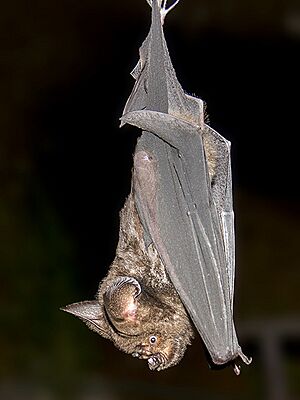Great roundleaf bat facts for kids
Quick facts for kids Great roundleaf bat |
|
|---|---|
 |
|
| Conservation status | |
| Scientific classification | |
| Genus: |
Hipposideros
|
| Species: |
armiger
|
 |
|
| Great roundleaf bat range | |
The great roundleaf bat is also known as the great Himalayan leaf-nosed bat. Its scientific name is Hipposideros armiger. This bat species belongs to the Hipposideridae family. You can find it in parts of South Asia, Southeast Asia, and China. These bats usually have two babies each year. The IUCN says this bat is a least concern species, meaning it's not currently at high risk of disappearing.
Contents
About This Bat
There are four different types, or subspecies, of the great roundleaf bat. They are:
- H. a. armiger
- H. a. fujianensis
- H. a. terasensis
- H. a. traninhensis
What Does It Look Like?
The great roundleaf bat looks a lot like its cousin, the intermediate roundleaf bat (H. larvatus). But there are a few key differences. The great roundleaf bat is bigger. It also has four small, leaf-like flaps on each side of its main noseleaf, while its cousin only has three.
This bat can have a forearm that is almost 10 cm long. It can weigh up to 60 grams, which is about the same as a small apple. Scientists once painted the noseleaf flaps and ears of these bats. They found that when the bats made clicking sounds, their noseflaps closed and their ears bent down. When they were listening, their noseleaf opened, and their ears went up.
Bat Life
Reproduction
Great roundleaf bats have babies once a year. They usually give birth to two young at a time. Female bats have been seen carrying babies from January to early May. Young bats stay attached to their mothers from February to June.
What Do They Eat?
These bats are insectivorous, which means they eat insects. Their favorite foods include beetles, butterflies, moths, flies, and Hymenoptera (like wasps and bees). You might spot them hunting for food in open woodlands, gardens, between rows of trees, and even near street lights.
How Do They Find Food?
The great roundleaf bat uses echolocation to find its way around and catch prey. This means they send out high-pitched sounds, usually between 65 and 75 kHz. They then listen for the echoes that bounce back. This helps them create a sound map of their surroundings.
Other Creatures
Sometimes, these bats can be a food source for a type of leech called Sinospelaeobdella. This is a jawed land leech.
Where Do They Live?
You can find the great roundleaf bat across many parts of South and Southeast Asia.
In South Asia, they live in Northern and Northeastern India. They are also found in Central, Eastern, and Western Nepal. In China, they live south of the Yangtze river, and also on the islands of Hong Kong and Taiwan. In Southeast Asia, they have been seen in Myanmar, Thailand, Laos, Vietnam, and Malaysia. These bats can live at different heights, from 100 meters up to over 2,000 meters above sea level.
These bats usually fly close to the ground. In South Asia, they prefer higher places like mountains and bamboo forests. They might roost (rest) alone or in small groups with other bats. They often share their roosting spots in caves, house attics, old house porches, and old temples.
In China, these bats live in many different places. They often roost in caves and man-made buildings. They can form large groups of hundreds of bats, sometimes sharing their homes with Rhinolophus bats.
In Southeast Asia, great roundleaf bats usually roost in caves. However, they are known to fly far away from their roosts to find food.
Protecting the Bat
The great roundleaf bat is quite common in the areas where it lives. It also has a large population. Because of this, the IUCN has listed it as a "least concern" species. This means it's not in immediate danger.
However, there are still some local threats to these bats. In South Asia, things like cutting down forests (deforestation), farming, mining, and disturbing their roosting places can be a problem. In Laos, Vietnam, and Thailand, disturbing their roosts and hunting them for food are also concerns. Luckily, these bats live in several protected areas across their range, which helps keep them safe.


